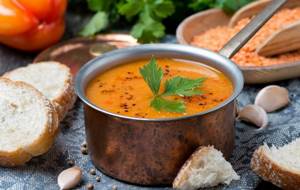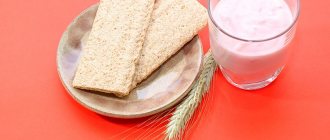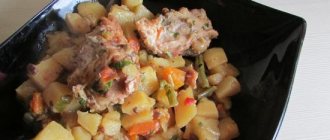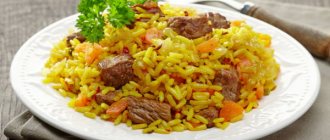Lentil soup
rich in vitamins and minerals such as: vitamin A - 13.3%, beta-carotene - 14.5%, vitamin B1 - 12%, vitamin B6 - 23%, chlorine - 11.4%
- Vitamin A
is responsible for normal development, reproductive function, skin and eye health, and maintaining immunity. - B-carotene
is provitamin A and has antioxidant properties. 6 mcg of beta carotene is equivalent to 1 mcg of vitamin A. - Vitamin B1
is part of the most important enzymes of carbohydrate and energy metabolism, providing the body with energy and plastic substances, as well as the metabolism of branched amino acids. A lack of this vitamin leads to serious disorders of the nervous, digestive and cardiovascular systems. - Vitamin B6
is involved in maintaining the immune response, processes of inhibition and excitation in the central nervous system, in the transformation of amino acids, the metabolism of tryptophan, lipids and nucleic acids, promotes the normal formation of red blood cells, and maintaining normal levels of homocysteine in the blood. Insufficient intake of vitamin B6 is accompanied by decreased appetite, impaired skin condition, and the development of homocysteinemia and anemia. - Chlorine
is necessary for the formation and secretion of hydrochloric acid in the body.
more hide
You can see the complete directory of the most useful products in the application
Mar-26-2013
Dietary properties:
What calorie content does lentils have, what dietary properties does it have? All this is of great interest to those who lead a healthy lifestyle and watch their figure. So we will try to answer these questions in the next article.
Today, specialists, nutritionists and doctors are confident that there are many beneficial properties that this cereal has. And the number of calories in lentils is of interest primarily to those who are struggling with excess weight or are afraid of gaining weight. Moreover, this product is considered dietary.
Lentils rank first among legumes in terms of the amount of vegetable protein it contains, which is easily digestible and perfectly nourishes the body. Vegetarians believe that it can replace meat due to its high protein content - approximately 60%. But it contains practically no fat, which can also be attributed to its dietary properties. This crop is a champion in folic acid content (vitamin B9) - per 100 g. The product accounts for almost 90% of a person’s daily need for it. Soluble fiber, another important component of this cereal, has an extremely beneficial effect on the functioning of the gastrointestinal tract.
The set of mineral components in lentils is very diverse, which largely determines the beneficial properties of this product. Of these, potassium, calcium, sulfur, phosphorus, magnesium, iron, zinc, manganese and so on can be noted.
Benefit
Lentils belong to the healthiest crops of the legume family. It satisfies the feeling of hunger for a long time, as it contains valuable slow carbohydrates.
What are the benefits of lentils:
- There are 26 g of protein per 100 g of product. In vegetarianism and dietary nutrition, lentils often replace meat. This significantly reduces fat intake in the daily diet.
- One serving of lentils contains the daily value of folic acid. This vitamin is essential for pregnant women.
- Cereals are rich in plant fibers or cellulose, which promote proper intestinal function. The product fights constipation and removes toxins from the body.
- A heavy dose of B vitamins improves the condition of the skin, hair and nails, and normalizes the functioning of the nervous system. The effect is noticeable after just a few weeks of regular use.
- Phytoestrogens in the composition minimize the symptoms of menopause in women.
Lentil composition:
Vitamins:
This cereal contains unique substances - isoflavones, which are believed to be beneficial for cancer.
These substances are preserved even if the product is processed, so you can safely use canned and dried lentils. Certain varieties of lentils, of which, by the way, there are quite a few, have the property of lowering blood sugar levels, making them useful for those suffering from diabetes. It is recommended to include puree from this cereal in the diet for colitis and gastric ulcers.
It, even in small quantities, satisfies hunger, giving the body enough protein and carbohydrates. Carbohydrates are broken down slowly, thereby maintaining a feeling of fullness for a long time. If you add to this a minimal amount of fat, it becomes clear what an irreplaceable dietary dish this product can be.
Summary
Lentil-based first courses will saturate the body with proteins, vitamins and microelements. They will leave you feeling full for a long time and prevent you from consuming extra calories.
Lentil soups are best cooked with vegetable broth. If desired, you can add ready-made boiled meat, chicken or fish to the soup. Lentil soup must be complemented with fresh herbs. Gourmets will appreciate the addition of garlic croutons or natural yogurt.
How to spend more time on yourself and your family, rather than spending hours cooking? How to make a dish beautiful and appetizing? How to get by with a minimum number of kitchen appliances? The 3in1 miracle knife is a convenient and functional kitchen assistant. Try it with a discount.
How many calories are in lentils?
Here's how much:
Naturally, the calorie content of lentils depends on the variety and method of preparation.
Pay attention to this table:
Table of lentil calorie content and nutritional value (BJU) per 100 grams:
| Lentils: | Bel, gr. | Fat, gr. | Angle, gr. | Cal, kcal. |
| Red dry | 26.0 | 2.0 | 57.0 | 350 |
| Red boiled in water | 7.9 | 1.1 | 19.6 | 97 |
| Green dry | 24.8 | 1.1 | 53.7 | 323 |
| Green boiled in water | 10.5 | 0.3 | 24.6 | 111 |
| Yellow dry | 22.3 | 1.0 | 65.5 | 332 |
| Yellow boiled in water | 6.0 | 0.5 | 22.0 | 107 |
| Canned | 8.6 | 0.6 | 17.5 | 110 |
| Sprouts | 9.0 | 0.6 | 22.1 | 119 |
Vitamins
Fat-soluble vitamins in lentils include A, beta-carotene, E and K. Water-soluble vitamins include vitamins C, B1, B2, B3 (PP), B4, B5, B6 and B9.
Vitamins, content Share of the daily norm g 100 per
| Vitamin A | 2.0 mcg | 0,2% |
| Beta carotene | 23.0 mcg | 0,5% |
| Alpha carotene | 0.0 µg | 0,0% |
| Vitamin D | 0.0 µg | 0,0% |
| Vitamin D2 | n/a | 0,0% |
| Vitamin D3 | n/a | 0,0% |
| Vitamin E | 0.5 mg | 3,4% |
| Vitamin K | 5.0 mcg | 4,2% |
| Vitamin C | 4.5 mg | 5,0% |
| Vitamin B1 | 0.9 mg | 72,8% |
| Vitamin B2 | 0.2 mg | 16,2% |
| Vitamin B3 | 2.6 mg | 16,3% |
| Vitamin B4 | 96.4 mg | 19,3% |
| Vitamin B5 | 2.1 mg | 42,8% |
| Vitamin B6 | 0.5 mg | 41,5% |
| Vitamin B9 | 479.0 mcg | 119,8% |
| Vitamin B12 | 0.0 µg | 0,0% |
| Fat soluble Water soluble |
How are lentils good for weight loss?
And further:
The only thing you need to know about this representative of the legume family is that:
- Before cooking, lentil grains of any variety should be soaked for an hour or two to reduce cooking time.
- Green lentils are great for salads because they perfectly retain their shape during heat treatment.
- Brown grains have a characteristic nutty aroma, they cook relatively quickly and are well suited for first courses.
- Beluga is a small, black legume, the most expensive and refined type of legume. It is typically used in recipes for side dishes and vegetable or meat stews.
- The red variety is a godsend for purees and cereals. This variety is a sprinter in cooking and cooks perfectly.
- A healthy and low-calorie way to eat lentils is to cook them in a vegetable soup or stew. It's best served with a slice of whole grain bread to get all the amino acids your body needs.
Lentil Soup Ingredients
Cooking method
Soak the lentils for 3 hours. Sauté onions and carrots in butter for 3 minutes. Combine sauteed vegetables with lentils and simmer until tender in a small amount of water. Add boiling water to the prepared stewed vegetables. Boil. Serve with sour cream and herbs.
You can create your own recipe taking into account the loss of vitamins and minerals using the recipe calculator in the application.
CHEMICAL COMPOSITION AND NUTRITIONAL ANALYSIS
Nutritional value and chemical composition of Lentil Soup.
The table shows the nutritional content (calories, proteins, fats, carbohydrates, vitamins and minerals) per 100 grams of edible portion.
| Nutrient | Quantity | Norm** | % of the norm in 100 g | % of the norm in 100 kcal | 100% normal |
| Calorie content | 67.8 kcal | 1684 kcal | 4% | 5.9% | 2484 g |
| Squirrels | 2.5 g | 76 g | 3.3% | 4.9% | 3040 g |
| Fats | 4.2 g | 56 g | 7.5% | 11.1% | 1333 g |
| Carbohydrates | 5.2 g | 219 g | 2.4% | 3.5% | 4212 g |
| Organic acids | 9.5 g | ~ | |||
| Alimentary fiber | 0.7 g | 20 g | 3.5% | 5.2% | 2857 g |
| Water | 79.6 g | 2273 g | 3.5% | 5.2% | 2856 g |
| Ash | 0.3 g | ~ | |||
| Vitamins | |||||
| Vitamin A, RE | 300 mcg | 900 mcg | 33.3% | 49.1% | 300 g |
| Retinol | 0.3 mg | ~ | |||
| Vitamin B1, thiamine | 0.04 mg | 1.5 mg | 2.7% | 4% | 3750 g |
| Vitamin B2, riboflavin | 0.03 mg | 1.8 mg | 1.7% | 2.5% | 6000 g |
| Vitamin B4, choline | 12.1 mg | 500 mg | 2.4% | 3.5% | 4132 g |
| Vitamin B5, pantothenic | 0.009 mg | 5 mg | 0.2% | 0.3% | 55556 g |
| Vitamin B6, pyridoxine | 0.01 mg | 2 mg | 0.5% | 0.7% | 20000 g |
| Vitamin B9, folates | 1.4 mcg | 400 mcg | 0.4% | 0.6% | 28571 g |
| Vitamin B12, cobalamin | 0.04 mcg | 3 mcg | 1.3% | 1.9% | 7500 g |
| Vitamin C, ascorbic acid | 0.6 mg | 90 mg | 0.7% | 1% | 15000 g |
| Vitamin D, calciferol | 0.02 mcg | 10 mcg | 0.2% | 0.3% | 50000 g |
| Vitamin E, alpha tocopherol, TE | 0.1 mg | 15 mg | 0.7% | 1% | 15000 g |
| Vitamin H, biotin | 0.4 mcg | 50 mcg | 0.8% | 1.2% | 12500 g |
| Vitamin RR, NE | 0.615 mg | 20 mg | 3.1% | 4.6% | 3252 g |
| Niacin | 0.2 mg | ~ | |||
| Macronutrients | |||||
| Potassium, K | 81.3 mg | 2500 mg | 3.3% | 4.9% | 3075 g |
| Calcium, Ca | 19.1 mg | 1000 mg | 1.9% | 2.8% | 5236 g |
| Silicon, Si | 7.1 mg | 30 mg | 23.7% | 35% | 423 g |
| Magnesium, Mg | 8.9 mg | 400 mg | 2.2% | 3.2% | 4494 g |
| Sodium, Na | 13.9 mg | 1300 mg | 1.1% | 1.6% | 9353 g |
| Sera, S | 16.7 mg | 1000 mg | 1.7% | 2.5% | 5988 g |
| Phosphorus, Ph | 33.5 mg | 800 mg | 4.2% | 6.2% | 2388 g |
| Chlorine, Cl | 161 mg | 2300 mg | 7% | 10.3% | 1429 g |
| Microelements | |||||
| Aluminium, Al | 36.2 mcg | ~ | |||
| Bor, B | 62.5 mcg | ~ | |||
| Vanadium, V | 2.1 mcg | ~ | |||
| Iron, Fe | 1.5 mg | 18 mg | 8.3% | 12.2% | 1200 g |
| Yod, I | 1.2 mcg | 150 mcg | 0.8% | 1.2% | 12500 g |
| Cobalt, Co | 1.3 mcg | 10 mcg | 13% | 19.2% | 769 g |
| Lithium, Li | 0.1 mcg | ~ | |||
| Manganese, Mn | 0.1176 mg | 2 mg | 5.9% | 8.7% | 1701 g |
| Copper, Cu | 65.5 mcg | 1000 mcg | 6.6% | 9.7% | 1527 g |
| Molybdenum, Mo | 8.2 mcg | 70 mcg | 11.7% | 17.3% | 854 g |
| Nickel, Ni | 14.4 mcg | ~ | |||
| Rubidium, Rb | 10.7 mcg | ~ | |||
| Selenium, Se | 1.8 mcg | 55 mcg | 3.3% | 4.9% | 3056 g |
| Titanium, Ti | 26.4 mcg | ~ | |||
| Fluorine, F | 5.4 mcg | 4000 mcg | 0.1% | 0.1% | 74074 g |
| Chromium, Cr | 1.1 mcg | 50 mcg | 2.2% | 3.2% | 4545 g |
| Zinc, Zn | 0.2707 mg | 12 mg | 2.3% | 3.4% | 4433 g |
| Digestible carbohydrates | |||||
| Starch and dextrins | 3.4 g | ~ | |||
| Mono- and disaccharides (sugars) | 0.6 g | max 100 g |
The energy value of lentil soup is 67.8 kcal.
Main source: Internet. .
** This table shows the average levels of vitamins and minerals for an adult. If you want to know the norms taking into account your gender, age and other factors, then use the My Healthy Diet app.
Mineral composition
The ratio of mineral substances (macro- and microelements) contained in lentils boiled in water is presented in the table using diagrams.
Minerals, content Share of the daily norm g 100 per
| Calcium | 19.0 mg | 1,9% |
| Iron | 3.3 mg | 33,3% |
| Magnesium | 36.0 mg | 9,0% |
| Phosphorus | 180.0 mg | 25,7% |
| Potassium | 369.0 mg | 7,9% |
| Sodium | 2.0 mg | 0,2% |
| Zinc | 1.3 mg | 11,5% |
| Copper | 0.3 mg | 27,9% |
| Manganese | 0.5 mg | 21,5% |
| Selenium | 2.8 mcg | 5,1% |
| Fluorine | n/a | 0,0% |
Recipe calculator
The nutritional value
Serving Size (g)
NUTRIENT BALANCE
Most foods may not contain the full range of vitamins and minerals. Therefore, it is important to eat a variety of foods to meet the body's needs for vitamins and minerals.
Among the vegetables in the legume group, lentils are undeservedly deprived of attention, but in vain. Since ancient times, it has been known for its nutritional properties, which once helped overcome the famine period. This product is very similar in appearance to peas, but is much less popular due to its inconspicuousness and difficulty in growing. Lentils have a somewhat strange ripening process: while part of the stem is ready for harvest, the rest may still be completely immature. Therefore, due to the prevalence of labor costs over the profit from harvesting, today this legume crop is actively cultivated only in India. And from there it spreads all over the world - lentil dishes are prepared both in Russia and in Europe.
Given the level of satiety that this product provides, it would be worth finding out how many calories are in lentils, how to eat them correctly, what positive and negative qualities they have, and whether there is something in them that sets them apart from other legumes.
Recipes
Lentil soup diversifies your diet and saturates your body with vitamins and minerals. Due to the high content of protein, carbohydrates and dietary fiber, the dish will leave the body feeling full for a long time. Lentil soup is especially useful for women and children. This cereal can be included in the diet of children from 2 years of age.
With Chiken
Chicken meat perfectly complements the taste of bean cereals. To comply with the principles of dietary nutrition, it is better to cook the soup in vegetable broth. It is better to boil the chicken separately and add the meat to the finished dish.
Cooking steps:
- Boil 2 liters of water.
- Add finely chopped onions and carrots, celery, bell pepper.
- Skim off the foam and cook over low heat for 5 minutes.
- Peel 2 medium tomatoes, chop and place in a saucepan.
- Rinse a glass of red lentils thoroughly and add to the soup.
- Cook for 10-15 minutes covered.
- Add chopped potatoes and finely chopped boiled chicken breast fillet.
- Bring to readiness.
- Season with spices and fresh herbs.
- Let it brew for 5 minutes and serve.
Homemade croutons grated with garlic are perfect for this soup. The hot spice will pleasantly complement the taste of the dish, adding exquisite spiciness to it.
With tomatoes

Dietary puree soup will delight gourmets with its unusual consistency and taste. But the same dish with a minimum amount of spices will be an excellent lunch for kids.
Cooking steps:
- Rinse thoroughly with 2 tbsp. red lentils.
- Pour 2 liters of boiling water or broth and bring to a boil.
- Add 2-3 coarsely chopped potatoes to the preparation.
- Cook for 25-30 minutes.
- Meanwhile, fry finely chopped onion and grated carrots in vegetable oil.
- Add tomato paste or tomatoes in their own juice to the preparation.
- Simmer over medium heat for 2 minutes.
- Add the roast to the soup and cook for 5 minutes.
- Blend the soup with a blender until smooth.
- Pour into plates.
- Add finely chopped parsley and a small sprig of fresh mint to each serving.
The thickness of the puree soup can be adjusted based on personal preference. Increase the amount of potatoes to make the soup richer and purée-like.
How many calories are in lentils?
There are three main varieties of lentils suitable for food: black, red and regular, green-yellow, the most familiar to the eye. And, of course, they all differ, at least a little, in caloric content, their effect on the body, and even their chemical composition.
Regular lentils, the most commonly seen lentils while perusing the grocery aisle, are the lightest of the three varieties, as well as the richest in protein and the lowest percentage of carbohydrates. The calorie content of lentils is 295 kcal, of which 33% belongs to proteins, and this is the highest among all legumes. Lentils are even ahead of beans on this point, which makes them the main source of vegetable protein, especially valuable in a vegetarian diet. It should be noted that this protein is much easier to digest than proteins from the meat group, and especially from pork: lentils can be compared with it in terms of the percentage of protein. The calorie content of a cooked product is reduced by two and a half times, so do not be immediately alarmed by the indicator given for dry.
In addition to protein, lentils, like all vegetables, are rich in complex carbohydrates. They owe their high percentage – 63% – primarily to fiber. This dietary fiber, when ingested, suppresses the feeling of hunger for a long time. In addition, it perfectly helps to normalize and stimulate digestion and cleanse the gastrointestinal tract. Therefore, foods rich in fiber must be present in the diet almost every day. And by and large, lentils owe their calorie content to fiber. It is also important to pay attention to the fact that the fat in the product is no more than 5%. And these are not all the beneficial properties of lentils.
In terms of the content of folic acid (vitamin B9), lentils are among the leaders among plant foods: they contain almost 90% of folic acid from the daily requirement of an adult. This makes lentils an essential element in the menu of people with problems with the circulatory system, weakened immune systems, as well as pregnant women. In addition, lentils also contain a lot of potassium and magnesium, which are important for the condition of the heart and blood vessels, sulfur and zinc, manganese, iron and calcium. And another very interesting component of its chemical composition is isoflavones. These substances reduce the risk of occurrence and development of cancer, in particular breast cancer.
Red lentils do not differ much from other varieties in terms of calorie content in boiled and dry form, but still have several features. Firstly, it comes to a state of readiness much faster - in a quarter of an hour, which cannot be said about either black or green. Secondly, the protein content in it is slightly lower - 27%, as well as carbohydrates - 61%. Thirdly, the proportion of iron in it is higher than in other subtypes, and therefore it is recommended to use it for anemia. And the calorie content of red lentils is 313 kcal per hundred grams of dry product.
Black lentils are still slightly heavier in weight than their previous “sister”, but the protein level here is between those for red and green, and there are more carbohydrates than in other subspecies. The calorie content of black lentils reaches 322 kcal, where 31% comes from proteins and 66% from carbohydrates. It contains slightly more fiber than green, and it also acts as a powerful natural antioxidant and is not capable of absorbing toxins. In addition, black lentils help normalize blood pressure and liver function, strengthen the immune system and stress resistance.
It is noteworthy that, regardless of the variety, after heat treatment, lentils do not change their beneficial properties. Whether stewed, boiled or steamed, its effect on the body remains unchanged, and only the calorie content of lentils fluctuates. Boiled will “weigh” about 111 kcal, canned - 110 kcal.
Lentils in the diet of those watching their figure
Among lentil dishes, cutlets, which replace meat in vegetarian cuisine, and various kinds of soups are especially popular. They can be made with vegetable broth, a kind of lean version, or with meat broth, with the addition of meatballs made from minced pork or beef. Both of them are distinguished by their particular satiety and pleasant taste: despite their unprepossessing appearance, lentils are by no means so “bland” in terms of taste. Lentil soup, of course, will have significantly lower calorie content than one cooked in chicken broth. And although it is not able to fully replace animal protein with vegetable protein, in terms of calorie content, lentil soup is a good alternative to rich meat soups during a strict diet. It usually includes potatoes, carrots, onions, celery, greens and lentils themselves. With such a light recipe, the calorie content of lentil soup will show no more than 43 kcal per hundred grams. And for “heavier” variations, cooked in meat broth with minced beef, the “weight” will increase to 45 kcal per hundred grams.
Lentils are one of the oldest foods successfully cultivated by humans. It was held in high esteem by the ancient Egyptian pharaohs and the Babylonian nobility, and for ordinary people it always replaced meat and bread. The benefits of consuming this product are so great that lentils can become a source of fiber, quality protein, minerals and vitamins when consumed regularly. She has several more advantages, which we will discuss further. The low fat content, good glycemic index and low calorie content of boiled lentils make them indispensable in the diet.
Related Products
Chili soup (57 cal) Carrot coriander soup (100 cal) Vegetable soup (41 cal) Clear soup (8 cal) Chicken soup (60 cal) Potato soup (63 cal) Mushroom soup (51 cal) ) Tomato soup (43 cal) Bean soup (74 cal) Fish soup (16 cal) Turtle soup (53 cal) Onion soup (44 cal) Noodle soup (35 cal) Beef soup (50 cal) Pea Soup (67 cal) Vegetable Pasta Soup (44 cal) Broccoli Soup (60 cal) Homemade Soups (22 cal) Turkey Soup (38 cal) Cream Soups (52 kcal.) Meat soup (50 kcal.) Oyster stew soup (40 kcal.) Chinese soup (33 kcal.) Shark fin soup (46 kcal.) Cheese soup (76 kcal.)
Lentil varieties
This plant belongs to the legume family, just like beans and peanuts. It is cultivated in many countries, so there are quite a lot of varieties. On store shelves you can find orange, green, black and gold lentils. Regardless of color, it has excellent nutrient content. The color of the grains does not affect the taste.
Green lentils contain slightly more dietary fiber and protein and are superior to other varieties in these respects. But overall this is a very useful product. Each variety has its own subtle, specific taste. Brown lentils are used mainly for making soups. Boiled green fruits are added to salads. Red lentils are often used in sauces and purees.
Lentil varieties
The most popular are green and red lentils. It is worth noting that green lentils, unlike red ones, contain more fiber. This particular variety is used in the treatment of diabetes and constipation. Green beans of this crop are recommended for people suffering from digestive disorders. But it also takes the most time to prepare. First you need to soak the porridge, and then boil it for about an hour and a half.
Lentil lovers note that the taste of green lentils is much brighter than red or black ones. It is often combined with other types of cereals: rice, pearl barley, buckwheat. It is also great as a side dish for fish. In supermarkets you may find green beans called French lentils.
The benefits of red lentils include their high iron content. It is she who occupies a leading position in the content of this microelement. The maximum benefit is observed in patients with anemia. It cooks quite quickly, within 20-30 minutes. This factor is due to the fact that the beans are not covered in a hard skin. The second name for red lentils is Egyptian. Other varieties include the following:
- Brown;
- Yellow;
- Black;
- Lentils Pardina.
Nutritional value and calorie content
The peculiarity of this product is that, despite the presence of a large amount of nutrients, lentils contain virtually no fat. 100 grams contain about 53 g of carbohydrates, 35 g of protein, no more than 2 g of fat, 4.5 g of minerals, 4 g of fiber and 14 g of water. These indicators may vary slightly depending on the plant variety and the method of its cultivation.
Lentils are very often used during fasting, when food of animal origin is not allowed. These fruits can easily replace meat and saturate the body with essential vitamins and nutrients. The calorie content of boiled lentils and its nutritional value will be slightly different. 200 grams of such a product contains 18 g of protein, 40 g of carbohydrates, 4 g of sugar, 15 g of fiber and 138 g of boiled lentils (230 kcal per 200 g).
Video recipe for lentil soup: an option not for weight loss
If you are not losing weight right now, you can cook a delicious soup with potatoes and quinoa. The cooking process is not complicated:
Irina Polyanitsa My name is Irina, I am the owner and admin of the site, as well as the author of most of the recipes and articles. I love to cook simple and healthy delicacies. Certified gym instructor, personal trainer. She completed a course on nutrition and health at Stanford University, Stanford Introduction to Food and Health, as well as a course at Ludwig Maximilian University of Munich (LMU) Nutrition and Lifestyle in Pregnancy (about nutrition and lifestyle during pregnancy).
Compound
Lentils are an excellent natural source of fiber, as are all legumes. Its use not only provides the body with the daily norm of this substance, but also normalizes the functioning of the gastrointestinal tract, allows you to control appetite and weight and eliminate the problem of constipation. Lentils are also Proteins that are known to aid muscle development. This is especially true for those who follow a vegetarian menu. Protein is mostly found in animal foods, and lentils can be an excellent meat substitute. It is also a leader in the amount of vitamins.
This product is especially rich in thiamine (vitamin B1) and folic acid (vitamin B6). They are necessary for proper brain function and the absorption of nutrients by the body. Lentils also contain some minerals: iron, potassium, copper and magnesium. Potassium is essential for the heart muscle and reduces the risk of stroke and osteoporosis. Magnesium is needed for bone development, and iron is needed to prevent anemia. Copper is an antioxidant and protects cells from mutations. And given that the calorie content of boiled lentils is very low, it can be consumed without harming your figure.
Basics of proper nutrition
The basis of any dietary nutrition is calorie control and reducing the load on the gastrointestinal tract. Most diets involve avoiding fatty meats, fast food, high-calorie baked goods, and “food waste.” Nutritionists recommend gentle cooking methods and drinking enough liquid.
First courses are required in the diet menu. With their help, you can reduce the calorie content of your daily diet and even arrange fasting days. Soup allows you to prolong the feeling of fullness by “filling” your stomach with liquid. A full lunch of first and second courses will give you energy and vigor.
The first courses are suitable for any diet - protein, carbohydrate or fractional. The main thing is to cook them correctly!
Benefits of lentils
Due to its presence, lentils help reduce cholesterol levels in the blood. Soluble fiber blocks carbohydrates, which slows down the absorption process. There are no sharp fluctuations in blood sugar levels in the body, which is important for diabetics. A large amount of fiber allows you to quickly saturate the body.
That is why dishes made from this product are satisfying but low in calories. This property will be useful for those who watch their figure and adhere to a diet. The presence of a large amount of useful substances increases metabolism. Eating lentils improves digestion, lowers blood pressure and helps reduce the risk of dangerous diseases such as Alzheimer's disease, cataracts, diabetes or osteoarthritis.
Contraindications
Despite the large number of beneficial properties, lentils also have some contraindications. Firstly, excessive consumption of this product can lead to flatulence. Secondly, large amounts of protein can cause kidney disease, as there is an additional burden on filtering and removing fluid from the body. Large amounts of potassium can lead to the development of hyperkalemia. This disease manifests itself in the form of apathy, fatigue, breathing problems and numbness of the limbs. Therefore, lentils should be consumed in moderation, without reaching the point of fanaticism, like, in principle, any other product.
How to cook lentils
This product is very easy to prepare. Before using red or another color, you must rinse it thoroughly and remove debris. It does not need to be pre-soaked, which is very convenient. Take three parts liquid to one part lentils. If you place grains in boiling water, more vitamins will be retained in the finished product.
When the water boils again, reduce the heat. If you need crumbly lentils, for example, to prepare a salad, then you need to cook them for about 5-10 minutes. If you want a softer texture, cook longer. Knowing how to cook red lentils, you can prepare many wonderful dishes.
Cream soup
Lentil cream soup is not only healthy, but also tasty. To prepare, take 100 grams of grains, two cloves of garlic, one small onion, 10 grams of flour, one egg, croutons, butter, salt and pepper. Boil the lentils, add chopped onion and garlic and bring the dish to readiness. Then we rub it through a sieve. This will make the lentil cream soup more tender. Then lightly fry the flour in vegetable oil, add salt and spices and dilute with broth or broth left over from cooking the lentils. Serve this dish with croutons and chopped eggs. the calorie content of which will be very low, suitable for dietary nutrition. Use lentils in your diet and saturate your body with useful substances.
Masur-dal
This famous Indian soup is hearty, thick and perfect for the cold season. Red lentils are perfect for this soup!
- 1 cup lentils.
- 1 onion. Shred
- 2 cloves of garlic. Finely chop.
- 1 tomato.
- 1 tbsp. ghee. This oil is ideal for preparing this dish. But if you don’t have it, you can replace it with a vegetable one.
- 1.5 liters of water.
Now let's move on to the spices. If you are not too much of an adept of Indian cuisine and do not like too spicy food with a pronounced taste, then the amount of spices can be reduced at your discretion.
- 1 tsp. dry ginger.
- 1 tsp. turmeric.
- 1 tsp. chili pepper.
- 1 tsp. paprika.
- salt to taste.
This soup is easy to prepare. Take a saucepan with a thick bottom, add oil and spices. They need to be heated for 15 seconds, then add onion and garlic. Fry and add tomatoes. All you have to do is fill it with water! Cooking time is only 20 minutes!










